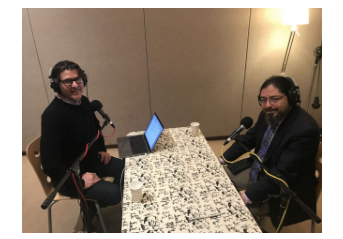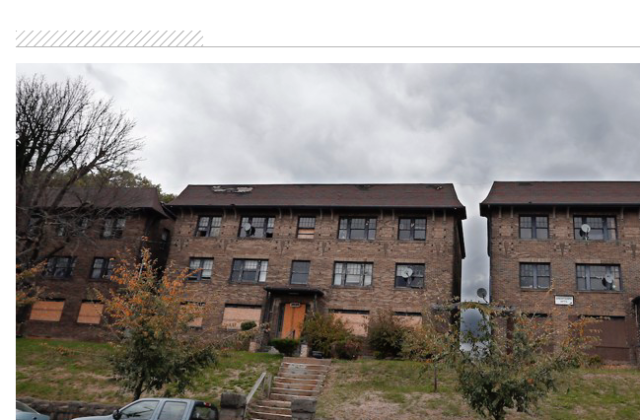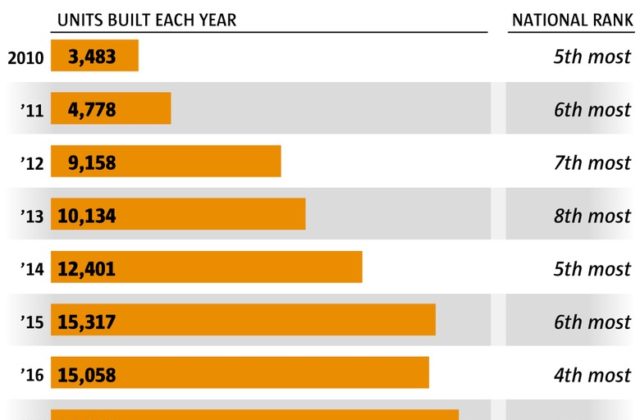EK On the Go: The Architecture of Discomfort
I’ve know Edward Krigsman as an innovator in the real estate world for more than a decade. When I left the public health world back in 2007, Krigsman was one of the first people I talked to about transitioning into a role that would give me an opportunity to be an advocate for more housing development. It took another 7 years for me to become director at Seattle For Growth, but our early conversations were helpful and instructive. Now Krigsman hosts a podcast and it’s just like we picked up our last conversation from years. ago. Check out his other guests as well for a view into an array of talent and interesting perspectives doing work in Seattle today.
Seattle Isn’t Dying Yet, But The Latest Debate Might Kill It
I’ve written a post at Forbes that seems to have gained some attention. It’s hard not to get attention about the KOMO program called Seattle is Dying. Everyone is talking about it. And I’ve given my caution about what conclusions to draw about the report. My latest post is taking a look at the two sides that have formed around the report, one that sees it as illegitimate propaganda and another that sees it as reflecting the “silent majority” that are enraged by tents and garbage in the streets. I think the way this whole thing is playing out misses the point that there is something to the report, but the people angry about tents and the homeless problem aren’t pro-housing or pro-growth, just anti-tent. Here’s the opening paragraph. You can read the whole article at Forbes.
By now, the local television report called, “Seattle is Dying” has become national fodder for the discussion of homelessness in large West Coast cities. The controversy that swirls around Seattle is Dying tells us more about the people upset by it than it does about the report. In Seattle, those angry about tents in public rights of way think the report gives voice to legitimate anger; those who think homelessness is an economic issue think the report is a hit job by Republicans (Sinclair owns KOMO the local station behind Seattle is Dying). What does all this tell us about Seattle in 2019?
Oregon and Rent Control: Frequently Asked Questions and Some Answers
Rent control is not going away. Oregon’s new law has sparked a lot of questions about whether it would work here. The Seattle Weekly posted an article last week about Oregon’s law asking, Would rent control work in Washington? If “working” means creating higher prices and more uncertainty in the housing market, sure, it will work. Would it help anyone? Only people lucky enough to land in a rent controlled unit. Otherwise it would work to make everything worse for everyone else. Here’s an FAQ on the Oregon law.
Frequently Asked Question – Oregon and Rent Control
What did Oregon’s legislature pass?
The legislature passed Senate Bill 608 that limits evictions and leases terms between property owners and tenants, including when rent can be increased.
How does Senate Bill 608 change rent increases?
Property owners are allowed one increase in rent per year of 7 percent plus the yearly change in the consumer price index (CPI). Property owners can raise rents up to 10.3 percent in 2019.
Who is exempt from the new law?
A property is exempt from the 7 percent plus CPI limit until 15 years from when their building was first occupied. Non-profits are also exempted.
How are eviction rules changed?
After the first year of tenancy, a property owner cannot evict a tenant unless she is planning to demolish the unit convert it to non-residential use, renovate the unit, if family is moving into the unit, or the unit is sold. In these cases, eviction can take place within “a reasonable time,” a term with no definition in the law. Finally, after giving a qualifying reason for eviction the property owner would have to pay the tenant one month’s rent when delivering the notice. The property owner also has to pay the renter an amount equaling one month’s rent when they deliver the termination notice — again, should they have a qualifying reason.
What’s wrong with Senate Bill 608?
- Proposed rent increases exceed the market norm– The rent increases are set higher than historic month over month or quarter over quarter or even year over year increases; the rent cap is set higher than the market. Because the legislator can adjust these later, property owners will have to raise their rents to the limits each year to ensure that they can cover operating costs. This will result in higher rent increases than usual and thus, demands for lower increases.
- Rent caps discourage improvements– When rents get adjusted lower, property owners won’t have flexibility to make repairs because they won’t be able to pay for them with capped rent revenue. The value of their investment will fall, and their incentive will be to sell or convert to another use – rent control only controls revenue, not expenses.
- Rent control discourages development – When rent growth is limited, supply is not increased, and demand keeps surging, only large scale developers will be able to build any housing to keep up with demand. When they do, they’ll have to charge as much as possible to stay ahead of the limits in Senate Bill 608; this is a recipe for inflation in the housing market.
- How does rent control make things worse? – When any producer of any product or service is limited in what she can charge for that product or service, it limits what she can borrow to increase production and generate a return on investment. Housing is no different; the uncertainty created by politicians controlling revenue from new housing will mean slower production and ironically, higher prices.
Would Senate Bill 608 make sense in Washington?
For all the reasons above, Senate Bill 608 is a bad idea for Washington State or any jurisdiction with growing demand and supply that is limited by too many limits on production (e.g. design review, impact fees). The best way to keep prices low is to build lots of housing, of all kinds, in every part of the state.
Richard Florida: Another Reason Why More Supply Won’t Solve High Prices
It’s simple. Like I said, so simple even a philosophy major and the Seattle Times understand it: when there is scarcity of something, it’s price goes up. Conversely, if that thing becomes less scare, prices go down. But the lengths to which opponents of increasing housing supply go to find other reasons to not allow more housing production never ceases to amaze me. I haven’t really wrapped my mind around the theory offered by researchers cited by Richard Florida in a recent post, but it is yet another attempt to show that what accounts for housing problems isn’t that housing is scarce but that greedy landlords are exploited the poor. Behold the new measure of Housing Exploitation:
They define housing exploitation as the amount of rent paid relative to the market value of that housing, and measure this exploitation as the ratio of annual rents from rental housing units over their combined property value. The level of exploitation rises as the ratio of rent to property value grows. (The study methodology accounts for the costs of upkeep and maintenance.) Desmond and Wilmers make use of two key sources of data: a large-scale national survey of rental properties, and a detailed set of surveys of renters and rental properties in Milwaukee.
So,
In high-poverty neighborhoods, those where 50 to 60 percent of residents live in poverty, the exploitation rate is 25 percent, meaning that 25 percent of the value of the property is paid back in a single year of rent.
The argument here seems to be that somehow it would be less exploitative or more just if cheap land had cheaper rents, at least as a ratio of rents over a period of time to the value of the land. OK. But why? Well, the assumption is that if I buy cheap land and charge rent that as a ratio to that land exceeds, well, 25 percent I am “exploiting” the renter. I make more “profit” because of this.
Nationally, landlords in poor neighborhoods derive a median profit of $298 monthly, compared with $225 in middle-class neighborhoods and $250 in affluent ones. In Milwaukee, the profit differential is even greater, with landlords in poor neighborhoods raking in $319 per month, more than double the profit ($174 per month) of landlords with properties in non-poor neighborhoods.
What?
The Housing Exploitation measure (my name for it) seems to be using the principle of capitalization rate which investors use to determine the potential return on a rental property. I emphasize potential because it’s a guess, and based more on rents and operating costs than the value of the land which can surge but doesn’t help offset changes in market rents or operating costs. Here’s a big slice of an Investopedia article on Capitalization Rate.
Examples of Capitalization Rate
Assume that an investor has $1 million and he is considering investing in one of the two available investment options – one, he can invest in government issued treasury bonds that offer a nominal 3 percent annual interest and are considered the safest investments and two, he can purchase a commercial building that has multiple tenants who are expected to pay regular rent.
In the second case, assume that the total rent received per year is $90,000 and the investor needs to pay a total of $20,000 towards various maintenance costs and property taxes. It leaves the net income from the property investment at $70,000. Assume that during the first year, the property value remains steady at the original buy price of $1 million.
The capitalization rate will be computed as (Net Operating Income/Property Value) = $70,000/$1 million = 7%.
This return of 7 percent generated from the property investment fares better than the standard return of 3 percent available from the risk-free treasury bonds. The extra 4 percent represents the return for the risk taken by the investor by investing in the property market as against investing in the safest treasury bonds which come with zero risk.
Hmmm. Is that 7 percent the same as the rate of Housing Exploitation? I don’t think it’s the same thing at all. What an investor is doing is using the land value and Net Operating Income (NOI) to calculate relative risk. Land value and rents definitely have a relationship and the profitability of a purchase of an existing building certainly is based on the relationship between the value of the land and the ability to generate rent. But rents are not set by landlords or captive to land value; it’s the other way around. Land gets valuable because of its rent potential, and that potential rises dramatically when demand for housing is high and available units are scarce.
So areas where the land value is low and rents are being set by the market, one could argue that the tenant is paying too much rent in relationship to the land. But why would you? If someone is paying $900 for a one bedroom apartment on a piece of land valued at $1,000,000 and someone else is paying $1,500 for an apartment on land valued at $5,000,000 so what? If the point is that we want the person who is paying $900 to see their rent drop, the best way to achieve that is allowing lots more housing in that neighborhood, especially if land is cheap. A capitalization rate can be low even when land value is high especially if rents stabilize.
What’s a good way to make things worse? How about taxing new housing in lower rent neighborhoods the way Councilmember Herbold has proposed. Suppressing new housing supply in places where land is cheaper by boosting it’s price won’t lower rents — it will push them higher because demand for those units will increase. This is just my first take at this and there may be something I am missing. I am gong to reach out to people who know a lot more about this and get more. But it seems to me that trying to measure exploitation is a waste of time; why not build more housing instead?
Email me with any thoughts on this: roger@seattleforgrowth.org
Seattle Times: More Housing Means Lower Prices
The headline in the Seattle Times tells the story of housing prices:”Seattle Rents Growing at Among Slowest Rates in Country as Apartment Boom Reaches Record.
And are prices growing slowly?
About 1 in 10 apartments across the city remain empty, and perks like a free month’s rent have become standard at most new buildings, and even some older ones.
And
At the same time, about 1 in 10 apartments across the city remain empty, and perks like a free month’s rent have become standard at most new buildings, and even some older ones.
It is so simple even the Seattle Times gets it, even acknowledging what Mike Scott called the “skew of the new” as why prices have gone up at all. New apartments — like a new sweater or car — are more expensive than older buildings.
But some in the city and the country are obsessing about eviction as a “crisis” when the answer to getting lower prices is right in front of them: more supply.







